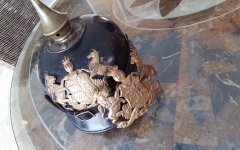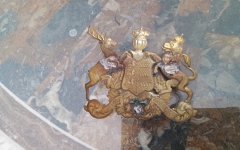USMC-EOD
Active member
I'm sure more than one member here has had this problem in the past.
A perfectly good wappen with one or both of the loops broken off...
I posted this little ersatz tin Wurtemburg pickelhaube with an officer's wappen incorrectly attached. I obtained an enlisted wappen, but the previous owner attempted to do "something".
I am not sure what the previous owner was trying to do exactly, but if his goal was to put big, ugly globs of solder and flux on different parts of the rear of the wappen without actually attaching new loops, then I would say he was very successful. See attached photo.
My plan is to buy a soldering iron and heat up and remove the old solder that was gooped onto the back of this thing.
Then i plan to get a good measurement by centering the wappen over the holes, bend some wire to the proper loop size, and nicely resolder some new loops on. I was thinking about hammering the "feet" of the wire loops flat so they solder on a little easier.
Does anyone know off-hand the standard diameter of the wire used on most wappen?
Are there any problems with this plan? Let me know!
Does anyone have any advice to make this little job easier?
Bryan.
A perfectly good wappen with one or both of the loops broken off...
I posted this little ersatz tin Wurtemburg pickelhaube with an officer's wappen incorrectly attached. I obtained an enlisted wappen, but the previous owner attempted to do "something".
I am not sure what the previous owner was trying to do exactly, but if his goal was to put big, ugly globs of solder and flux on different parts of the rear of the wappen without actually attaching new loops, then I would say he was very successful. See attached photo.
My plan is to buy a soldering iron and heat up and remove the old solder that was gooped onto the back of this thing.
Then i plan to get a good measurement by centering the wappen over the holes, bend some wire to the proper loop size, and nicely resolder some new loops on. I was thinking about hammering the "feet" of the wire loops flat so they solder on a little easier.
Does anyone know off-hand the standard diameter of the wire used on most wappen?
Are there any problems with this plan? Let me know!
Does anyone have any advice to make this little job easier?
Bryan.


